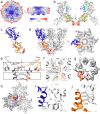Molecular architecture and conservation of an immature human endogenous retrovirus
- PMID: 37620323
- PMCID: PMC10449913
- DOI: 10.1038/s41467-023-40786-w
Molecular architecture and conservation of an immature human endogenous retrovirus
Abstract
The human endogenous retrovirus K (HERV-K) is the most recently acquired endogenous retrovirus in the human genome and is activated and expressed in many cancers and amyotrophic lateral sclerosis. We present the immature HERV-K capsid structure at 3.2 Å resolution determined from native virus-like particles using cryo-electron tomography and subtomogram averaging. The structure shows a hexamer unit oligomerized through a 6-helix bundle, which is stabilized by a small molecule analogous to IP6 in immature HIV-1 capsid. The HERV-K immature lattice is assembled via highly conserved dimer and trimer interfaces, as detailed through all-atom molecular dynamics simulations and supported by mutational studies. A large conformational change mediated by the linker between the N-terminal and the C-terminal domains of CA occurs during HERV-K maturation. Comparison between HERV-K and other retroviral immature capsid structures reveals a highly conserved mechanism for the assembly and maturation of retroviruses across genera and evolutionary time.
© 2023. Springer Nature Limited.
Conflict of interest statement
The authors declare no competing interests.
Figures





Update of
-
Molecular architecture and conservation of an immature human endogenous retrovirus.bioRxiv [Preprint]. 2023 Jun 7:2023.06.07.544027. doi: 10.1101/2023.06.07.544027. bioRxiv. 2023. Update in: Nat Commun. 2023 Aug 24;14(1):5149. doi: 10.1038/s41467-023-40786-w. PMID: 37333227 Free PMC article. Updated. Preprint.
References
-
- Lander, E., Linton, L., Birren, B. & Nusbaum, C. Initial sequencing and analysis of the human genome. Nature409, 860–921 (2001). - PubMed
-
- Büscher, K. et al. Expression of Human Endogenous Retrovirus K in Melanomas and Melanoma Cell Lines. Cancer Res.65, 4172–4180 (2005). - PubMed
-
- Kurth, R. & Bannert, N. Beneficial and detrimental effects of human endogenous retroviruses. Int J. Cancer126, 306–314 (2010). - PubMed
Publication types
MeSH terms
Substances
Grants and funding
LinkOut - more resources
Full Text Sources
Medical

